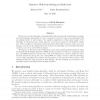302 search results - page 49 / 61 » Sequential circuits for program analysis |
ICML
2004
IEEE
14 years 8 months ago
2004
IEEE
Markov networks are extensively used to model complex sequential, spatial, and relational interactions in fields as diverse as image processing, natural language analysis, and bio...
POPL
2006
ACM
14 years 8 months ago
2006
ACM
Concurrency-related bugs may happen when multiple threads access shared data and interleave in ways that do not correspond to any sequential execution. Their absence is not guaran...
IFM
2009
Springer
14 years 2 months ago
2009
Springer
We present the new technique of dynamic path reduction (DPR), which allows one to prune redundant paths from the state space of a program under verification. DPR is a very general...
DAC
2010
ACM
13 years 11 months ago
2010
ACM
With the end of clock-frequency scaling, parallelism has emerged as the key driver of chip-performance growth. Yet, several factors undermine efficient simultaneous use of onchip ...
ICALP
2010
Springer
13 years 9 months ago
2010
Springer
We present a new deterministic sorting algorithm that interleaves the partitioning of a sample sort with merging. Sequentially, it sorts n elements in O(n log n) time cache-oblivi...

